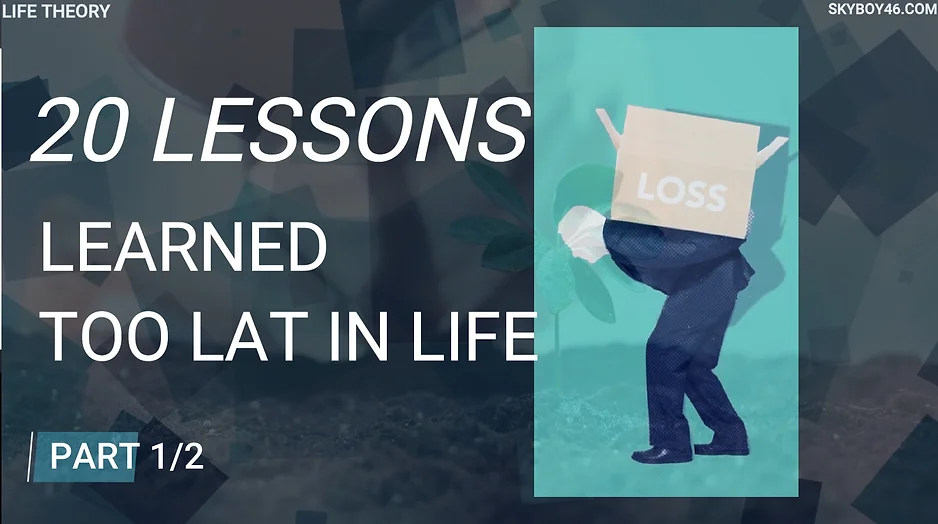Don’t Want To Read?
Watch/Listen To The Full Video on YouTube
Ever had one of those days where everything seems to go wrong? It’s easy to blame fate, but science suggests otherwise—our perception, sleep, and stress levels shape how we experience setbacks. Small inconveniences stack up when we’re already mentally drained, turning a minor mishap into a downward spiral. The good news? Once you recognize this pattern, you can take control and shift the course of your day.
SUBSCRIBE: https://www.youtube.com/@LifeTheory46
The Real Reason Behind Bad Days – Life Stories 301
We all know that feeling. Sometimes, from the very first hour, you can just sense it—this day is not going to be kind. Your mood sinks, things don’t go as planned, and you keep stumbling into one mishap after another. But is there really a reason why these small, frustrating moments seem to stack up, forming a chain of chaos? Why do you seem to stub your toe, spill your coffee, and leave your headphones behind, all before lunch? To uncover what’s really happening, we need to explore two factors: coincidences and the mind’s role in it all.
Let’s start with an extraordinary story that illustrates the randomness of life: the tale of Laura Buxton’s balloon. Back in 2001, during her grandparents’ 50th wedding anniversary in Staffordshire, England, 10-year-old Laura released a helium balloon with a note that simply read, “Please return to Laura Buxton,” along with her address. That balloon drifted 140 miles away, landing in the hands of a farmer named Andy, who happened to know another Laura Buxton living nearby. The catch? This wasn’t the original Laura who launched the balloon—it was a different girl, of similar age, and when the two Lauras got in touch, they discovered they shared more than a name. Both had brown hair, were unusually tall for their age, and had pets that matched: a three-year-old black female Labrador, a rabbit, and a guinea pig.
It’s tempting to see this as fate, a sign of some cosmic connection at work. But before we get swept up in the wonder, probability theory steps in to bring us back down to earth. Many aspects of the Lauras’ story are statistically explainable. Their physical resemblance isn’t shocking, considering they lived within the same region. Even the similarities in pets aren’t that extraordinary; dogs, rabbits, and guinea pigs are quite common in British households. And while the journey of that balloon across 140 miles seems remarkable, mathematics tells us it’s not beyond expectation.
As David Hand, a professor at Imperial College London, puts it, “Highly improbable events are quite common.” His explanation? Our brains tend to notice coincidences that seem meaningful to us. Amid the countless events happening every day, we only take note when something stands out, making it seem like a destined encounter when, in reality, it’s just another outcome of chance.
If you think about it, even the eeriest coincidences have mundane explanations when viewed through the lens of probability. For instance, with 23 players on a football pitch, there’s a 50/50 chance that at least two will share the same birthday. The odds increase dramatically if we include birthdays that fall within a few days of each other. Even fictional events that eerily mirror real-life tragedies, like the story of The Wreck of the Titan—a novel about a massive ship sinking after hitting an iceberg, written 14 years before the Titanic—can be understood as uncanny predictions rather than premonitions.
So, what about bad days? Is it really just a string of coincidences conspiring against you? Science suggests otherwise. A bad day often starts with a lack of rest. If you didn’t get enough sleep, your body’s natural functions are thrown off balance. You’re more likely to be groggy, thanks to sluggish neurons, and your serotonin levels, which help regulate mood, may be out of whack. This sets the stage for a downward spiral where every little frustration feels amplified.
Consider the coffee spill on your shirt. Running late and changing clothes can cost you extra minutes, increasing the likelihood of hitting traffic, where tensions already run high. And if you’re sleep-deprived, your mind is less capable of coping with these stresses, so each inconvenience feels like a personal attack by the universe.
The truth is, when you’re already running on low energy, your mind becomes primed to perceive everything through a negative lens. The day isn’t actually cursed—it’s just a matter of stacking small stressors that your tired brain struggles to process. The more these little things accumulate, the harder it becomes to shake off the feeling that it’s just “one of those days.”
But here’s the good news: you have more power to turn it around than you think. If you want to break free from the grip of a bad day, something as simple as stepping outside for a walk can do wonders. The fresh air sends a rush of oxygen through your body, improving blood flow to your brain and helping to lift your mood. The act of walking itself can help you step out of the cycle of frustration, shifting your focus away from whatever has been weighing you down.
Ultimately, a bad day isn’t a grand scheme by some higher power or a series of omens signaling disaster. It’s simply a collection of small, unfortunate events that stack up, often made worse by a fatigued mind. And when you begin to recognize this, you also realize that you have the choice to rewrite the rest of your day. You can get unstuck, regain control, and remind yourself that even on your worst days, you still have the ability to change how things unfold.
So next time you feel the world is against you, take a breath, get some fresh air, and remember—it’s just a rough patch, not a prophecy.
–> Read More Life Stories Here:
https://www.lifetheory.us
https://www.lifetheory.eu
Buy all of our Life Stories & Our Premium Learning Packs. Listen or Read to them anytime you want. Have them Forever.
You can get each monthly lesson on our website at https://www.skyboy46.com/store
SHARE THIS STORY
Visit Our Store
SHOP NOW
www.skyboy46.com & www.myskypet.com
Designed For Pet Lovers & Introverted Souls
Sport, Hobbies, Motivation, Music & Art






~EXPLORE MORE~
www.linktr.ee/skyboy46


